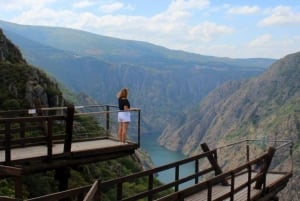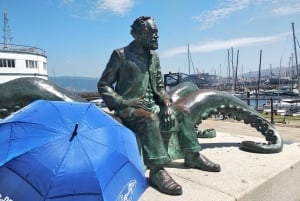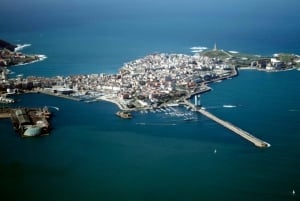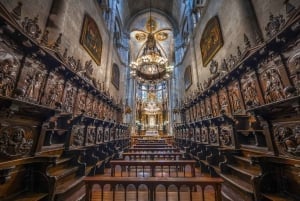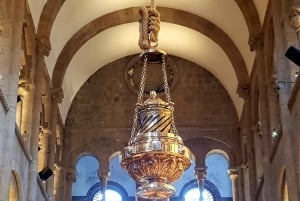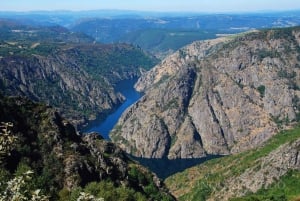Galicia Regional Info
Galicia in north-west Spain is a land of mysteries and surprises. So with its fascinating cultural tapestry, extraordinary natural beauty and landscapes, remarkable Celtic heritage and Roman legacy it is one of the wonders of the world to get to know, discover and experience! Pilgrims from all over the world converge on Santiago de Compostela which is a majestic and ancient capital situated in the heart of Galicia, whose four provinces and principal cities are La Coruña, Lugo, Ourense and Pontevedra in which Vigo, close to the Cies IsIands, is the largest city. Baiona, Sanxenxo, Cambados, O Grove, La Toja, Mondariz, Finisterre, Tui and A Guarda close to Northern Portugal, are some of the villages worth savouring.
Sailing in Rias Baixas
There is the breathtaking, wild northern coastline which starts at the Costa Da Morte and finishes at Ribadeo on the Asturian border and is known as the Rias Altas. The west coastline comprises of a series of old and unique, fjord-like sheltered estuaries that contain numerous safe swimming beaches and precious islands including the National Park of Las Islas Atlanticas, the most famous of which is the Cies Islands (Islas Cies). This coastline extends to the border with Portugal, separated by the hugely impressive river Mino and is known as the Rías Baixas. Galicia is also relatively mountainous where there are many nature reserves with magical streams, rivers and woodlands together with an abundance of wildlife, picturesque villages, castles, monasteries, ruins and old farming practices which time has almost forgotten. Galicia is also renowned for its friendly people, innovative culture, delicious food especially seafood delicacies, high quality wines and famous cellars, magnificent architecture and religious heritage.
In fact in Galicia there are 1000 rivers, 1300 kilometres of coastline, 700 beaches of which 126 are Blue Flag beaches, 21 balnearios (unique spa resorts) and a staggering 5,146 restaurants!
Monastery at Oia
No visit to Galicia is complete without experiencing Santiago de Compostela, the ancient, administrative capital and arguably after Rome and Bethlehem the third most religious city in the world, with its stunning, granite cathedral and UNESCO World Heritage status covering its beautiful old medieval core. It's famous throughout the world for its pilgrimage route "el Camino de Santiago".
Santiago de Compostela Cathedral
La Coruña is arguably the most prosperous city and financial centre with is stunning peninsular setting surrounded by the sea and maritime legacy. This is the place to relax and shop at the heart of Galicia's clothing industry with world famous brands such as Zara, Massimo Dutti, and Caramelo. La Coruna is also the home of the famous Galician brewery, Estrella de Galicia whose beers are appreciated throughout Spain. The bars and restaurants of La Coruna are a gastronomic delight and the nightlife vibrant and safe.
La Coruña
Vigo is also stunningly located in the heart of the Ría de Vigo and is Spain's most important fishing port. It''''s also the gateway to the Rías Baixas with a diversity of places to visit including Pontevedra, O Grove, and Sanxenxo. To the south of Vigo is Baiona and the Parador there is no doubt the best hotel in Spain. From Baiona there are incredible views towards the Islas Cíes which are the most important nature conservation site in Spain.
Islas Cíes
Galicia is relatively easy to get too and there are airports at Santiago, La Coruña and Vigo with regular, scheduled cheap flights to London and other major European/world destinations serviced by airlines such as Iberia, Air Norstrum, Vueling, Ryan Air and Easy Jet. It also possible to travel via Porto which is less than an hour drive from Galicia with cheap flights, for example, by TAP, British Airways, Easy Jet and Ryan Air, from most European/world destinations. Motorists from the UK can arrive either via Brittany Ferries or P&O Ferries to Bilbao or Santander or visitors can travel via France. Transport links within Galicia are excellent with regular bus and high speed train services radiating from the main cities. The motorways are a driver''''s paradise despite the small toll charges.
The official languages are Castellano Spanish and Galician (Gallego) which sounds like a rich combination of Portuguese and Spanish. While younger people can speak English or other European languages, given there are comparatively fewer English speaking visitors, travellers are guaranteed a very authentic introduction to local culture and traditions far removed from their own experience.
Galician hospitality is memorable and a warm, trouble-free welcome awaits any visitor spoilt for choice with an amazing variety of bars, pubs and nightclubs. Places are incredibly generous with the size and quality of drinks. The atmosphere and vibrancy of Galician cities at night is a very special and completely different experience. In La Coruña this is concentrated around streets such as Calle Barrera. In Santiago de Compostela its during student term time especially on Thursday, Friday and Saturday where it reaches fever pitch and in Vigo people go out partying until 8 am!
Pazo de Fefinanes, Cambados
Thanks to its diversity Galicia is a place to suit all tastes from families to pilgrims to surfers. This short introduction cannot possibly give justice to what Galicia can really offer and the following places to name but a few are also recommended: Lugo, Ourense, Betanzos, Finisterre, Cambados, A Guarda and Ribadeo and numerous spa resorts like La Toja, Mondariz and Guitiriz. Further information can be found on this site on all these places including links to general tourist information and some of the main tourist websites for the main cities and towns. It is also easy to visit northern Portugal from the south of Galicia which brings beautiful medieval cities like Oporto, Braga and Guimarães within reach for day trips/short stays. In addition, Galicia has borders with both the regions of Asturias and Castilla y León. Visit inspirational Galicia in north-west Spain and discover a new way of living - Galicia Calidade!
A great time to visit is during Xacobeo & the Holy Year celebrations when the Festival of St. James the Apostle on 25 July falls on a sunday. El Camino de Santiago (St. James Way) is one of the the world´s most popular pilgrimage routes & St. James the Apostle awaits.Xacobeo celebrates this special year. The ten ways to Santiago, concerts, cultural and gastronomic events, spiritual & religious activities, pilgrims, life changing experiences, nature and tourism - this is the very spirit of Xacobeo! The next Xacobeo is in 2021.
A Brief Tour of places to visit in the Mondariz Area
Balneario de Mondariz


